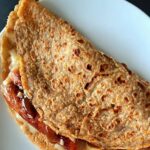
Staffordshire Oatcakes
These easy, economical yeasted oatmeal pancakes are a speciality of north Staffordshire and are usually served alongside or filled with traditional breakfast foods like sausage, bacon, mushrooms, tomatoes, plus cheese.
But, as with other pancakes, there's no reason you can't eat them with sweet fillings too.
Ingredients
- 125 g oatmeal, fine or medium see Recipe Note 1 including making your own
- 75 g wholemeal bread flour or plain wholemeal flour: see Recipe Note 2
- 50 g plain white flour can be replaced with more wholemeal flour
- 1 tsp instant dry yeast the type that doesn't need activating first
- 1 tsp salt
- 250 ml water
- 250 ml milk can be replaced with more water: see Recipe Note 3
- oil e.g. sunflower for greasing griddle or pan
Instructions
-
Put the oatmeal and flours into a mixing bowl along with the salt and yeast.
-
Method 1: Making the batter the same day as the oatcakes.
Combine the water and milk and heat to 38°C. If you don't have a thermometer then heat until it feels just warm when a finger is held in it: if in doubt, err on the side of cooler as hot liquid will kill the yeast.
Method 2: Overnight batter.
A longer, overnight fermentation should give better flavour. For this method there's no need to heat the liquids.
-
Stir the contents of the mixing bowl then gradually pour in the combined water and milk, whisking all the time to create a batter the consistency of single cream. Add a splash more water if necessary.
Method 1: Cover and place somewhere warm for 15 - 30 minutes or until the surface is foamy.
Method 2: Cover and leave at room temperature overnight.
-
Put a 15 - 18 cm pancake, crepe or shallow non-stick frying pan over medium-high heat.
When hot, brush over a thin layer of oil then pour or wipe off any excess.
Whisk the batter and, if necessary, add a little more water to bring it back to single cream consistency. For easier pouring, you can now transfer it to a jug. Otherwise, you'll need a ladle.
Pour or ladle approximately ⅛ of the batter into the pan: quickly lift and tilt the pan so the batter flows over and covers the base. If your pan is hot enough, you should immediately see bubbles forming and popping.
Cook until the underside is golden brown and the top is dry with no loose batter (approx. 1½ - 2 min). Turn and cook the other side until it's set and covered in darker brown patches.
Transfer the oatcake to a cooling rack or plate.
Re-oil the pan and continue making oatcakes until all the batter is used up. Remember to stir the batter before pouring each time. Stack each oatcake on top of the previous one.
-
Storing and reheating.
Oatcakes will keep at least 2 - 3 days covered and stored in the fridge. They can also be frozen: stack them with cling film or greaseproof paper between each one or roll, freeze on a lined tray then transfer to a freezer bag.
Oatcakes can be quickly reheated in a microwave but are better in a lightly greased pan or under the grill.
Serving suggestion: have ready some cooked bacon or sausages.. Leave a little of their cooking fat in the pan, put in an oatcake and reheat on both sides. Sprinkle with cheese, allow it to melt, then top with hot bacon or sausage plus a squirt of ketchup or brown sauce if liked. Roll or fold then transfer to a plate to serve.
Recipe Notes
Note 1 Oatmeal. Although in the US oatmeal refers to what we in the UK call porridge, over here oatmeal is a flour made from ground oats. You're more likely to find it in a health food shop rather than a supermarket, but you can easily make your own by whizzing up rolled oats or porridge oats in a blender or food processor.
Note 2 Type of flour. Using bread flour gives strength to the oatcakes, making them less likely to break when turning or folding. Personally, I prefer the texture too. But plain flour can be substituted if that's what you have. Some or all of the wholemeal flour can also be replaced with white flour.
Note 3 Water and/or milk. Traditionally, the only liquid in oatcakes would be water. But a mix of half milk and half water is now common for the homemade version as it gives better flavour. If you prefer water only, I recommend adding a teaspoon of sugar to the flour: this will help feed the yeast in the absence of the sugar (lactose) found in milk.